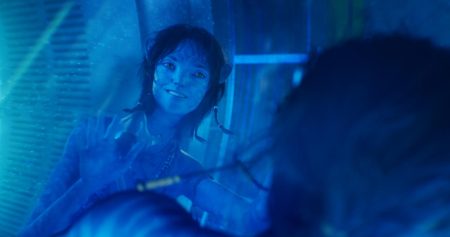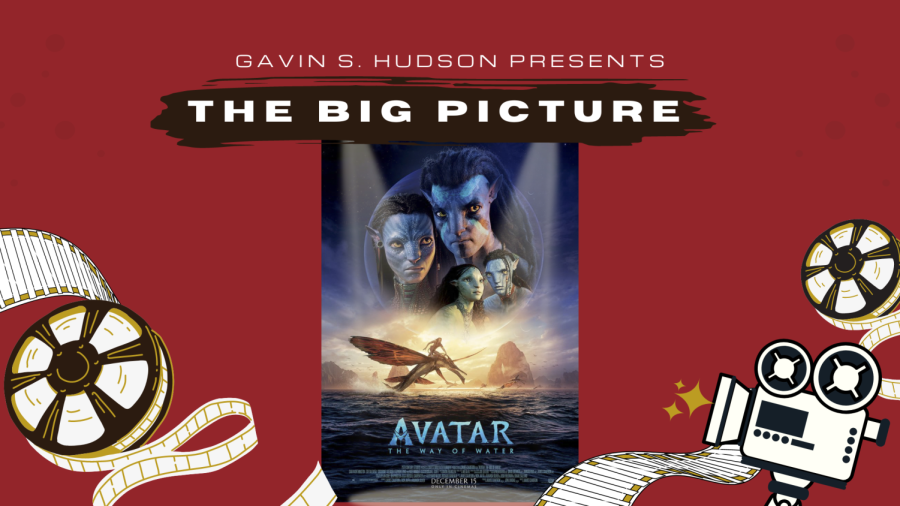The Big Picture – Avatar: The Way of Water
Graphic created in Canva by Dominique Williams and Gavin S. Hudson. Movie posters courtesy of 20th Century Studios.
December 17, 2022
Disclaimer: Light spoilers for the film are included in this review.
It’s always puzzled me how Avatar (2009) became the highest grossing film of all time. With its visual effects being immensely ahead of its time, the spectacle had an understandable amount of draw, but by no means was it fascinating enough to deserve the profits it earned.
With director James Cameron cajoling viewers to return to the theaters, saying, “[fans can see the scene they missed when they come see it again,” and even comparing the film to classic Hollywood fiction like Star Wars or the Marvel Cinematic Universe, it felt like Cameron had something to prove. Despite the overtly pretentious comments by the film’s director, Avatar: The Way of Water is a misfire.
The visuals have been the focal point of praise and deservedly so: despite having a $250 million budget (smaller than many blockbusters with lesser effects), the film looks absolutely gorgeous. This is where the film promised the most and thankfully, this is where it best delivers.
The lighting, character and creature design, texture and even the water look unbelievably life-like. Credit where credit is due to the VFX artists: I’d go as far to say this is an instant Oscar-lock for best special effects.

Aside from the visuals, the “The Way of Water” is underwhelming in a few important areas.
After the first 20 minutes, most of the footage from the trailer has been shown, which gave me hope that beyond that, I’d experience a story composed of surprises. Instead, hope was slowly snuffed out over the course of a startling three-hour run time.
While it’s apparent that both films in this franchise are allegorical for the trials and tribulations experienced by native peoples, the heavy-handed messaging is as subtle as a police siren. With how often they mention ‘the power of family,’ you’d expect to see Dominic Toretto with a writing credit.
Characters undergo arcs that feel undeserved by the end of the film. Far too many “main characters” feel tossed aside for long periods while other characters embark on separate journeys.
When “The Way of Water” elects to build its world and characters, the interesting concepts that are presented go unresolved in a fashion that makes you think, “well that was pointless” instead of, “I wonder where that will go next.” While I understand this film is supposed to be the second of five, audiences waited thirteen years to experience this story:- you shouldn’t just leave them questioning why something was included if it didn’t have a realized impact to the rest of the story.

The returning characters experience predictable arcs hastily set up within the first ten minutes. Zoe Saldana’s character feels especially excluded from having her own arc and only pops up when suitable for emotional tonality.
The main character, Jake Sully, ends up getting a watered down “learning to be a father” with only a few scenes capturing the dynamic.
Most of the conflict is caused by the same series of events. rarely occurring naturally. Each action scene occurs for the sake of the plot, without having any stakes to keep the audience actively engaged.
The consequences presented feel required rather than earned and hardly provide enough emotional weight to have any impact on the audience afterwards, sacrificing an ill developed character for the sake of an emotional scene that only exists to the characters and not the audience.
The film aims to create a global sense of unity on Pandora and yet, during the third act, all of the other characters just disappear for a bit with no explanation until the conflict ends. Moments like these are prime examples of how “The Way of Water” distracts itself from more interesting concepts in favor of an ending that resonates as cliche instead of endearing.
The visual effects help the film stand out, but hardly anything else helps the movie feel memorable. The highly anticipated disappointment, “Avatar: The Way of Water” gets a 6/10.



































































































































